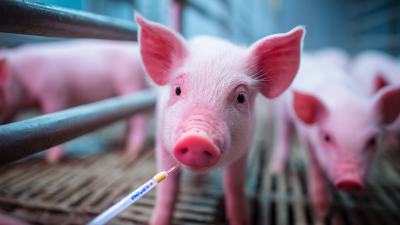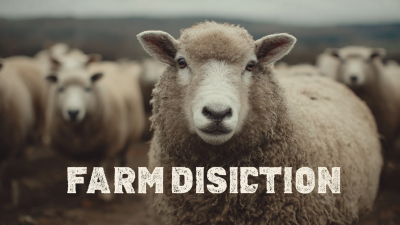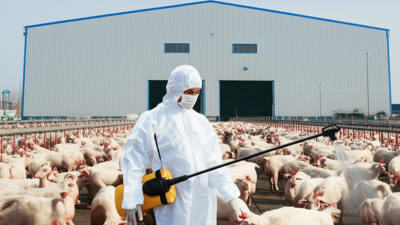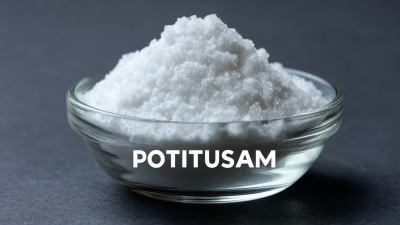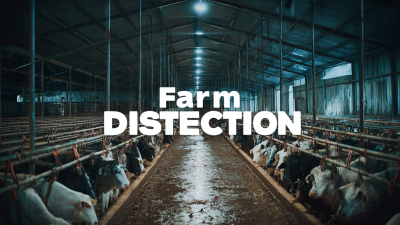In the poultry farming industry, maintaining biosecurity is paramount to ensure the health and productivity of flocks. According to the World Organisation for Animal Health, the prevalence of infectious diseases in poultry can lead to significant economic losses, with estimates suggesting that up to 20% of poultry production can be compromised by disease outbreaks. One of the most effective strategies to combat these threats is the use of Chicken Disinfectant. These specialized disinfectants are designed to eliminate harmful pathogens from poultry environments, thereby reducing the risk of disease transmission. The effectiveness of Chicken Disinfectant not only helps in safeguarding the health of the birds but also enhances overall farm productivity and profitability. In this blog, we will explore the importance of Chicken Disinfectant in poultry farming, highlighting best practices for its application and the profound impact it has on biosecurity measures.

In poultry farming, maintaining a clean and disease-free environment is crucial for the health and productivity of the flock. Chicken disinfectants play a vital role in this endeavor by effectively reducing the presence of pathogens that can cause serious illnesses. According to the World Organization for Animal Health (OIE), the avian influenza virus can survive on contaminated surfaces for up to 105 days, emphasizing the need for rigorous biosecurity measures that include regular disinfection. Using effective disinfectants can significantly lower this risk, thereby protecting both animal health and farm profitability.
Research from the National Chicken Council indicates that poultry diseases can result in economic losses that exceed billions of dollars annually due to decreased production efficiency and increased mortality rates. Implementing a robust disinfecting regimen not only aids in preventing outbreaks but also enhances the overall welfare of the birds. For instance, a study published in the Journal of Applied Poultry Research noted that farms utilizing proper disinfectant practices saw a 30% reduction in disease incidents, showcasing the direct correlation between biosecurity measures and flock health. Given these statistics, the investment in quality chicken disinfectant is not just a matter of hygiene; it is a fundamental component of successful poultry farming.
In the realm of poultry farming, the economics of disease prevention is paramount. Effective disinfection plays a critical role in safeguarding flocks from infectious diseases, which can lead to significant financial losses. By maintaining a rigorous disinfectant protocol, poultry farmers can reduce pathogen loads in their environments, lower the incidence of disease, and improve overall flock health. This proactive approach not only minimizes veterinary costs associated with treatment and vaccination but also enhances productivity by ensuring that birds grow healthier and more efficiently.
Investing in high-quality chicken disinfectants may require an upfront expenditure, but the long-term benefits can far outweigh these initial costs. Healthy birds yield higher meat and egg production, which translates to increased revenue. Additionally, minimizing disease outbreaks cultivates a more robust supply chain, allowing farmers to meet market demands without interruptions. Overall, the integration of effective disinfection strategies is essential for fostering a sustainable and profitable poultry farming operation.

In poultry farming, the use of disinfectants plays a vital role in maintaining the health and productivity of chickens. Key ingredients commonly found in chicken disinfectants, such as quaternary ammonium compounds, hydrogen peroxide, and iodine-based solutions, have demonstrated efficacy in eliminating a wide range of pathogens. According to a study published in the Journal of Applied Poultry Research, appropriate disinfectant application can reduce bacterial contamination by up to 99.9%, significantly lowering the risk of disease outbreaks in flocks.
Moreover, the effectiveness of these disinfectants is further supported by industry research which highlights their ability to break down biofilms and control transmissible diseases like coccidiosis and avian influenza. A 2022 report from the National Poultry Association emphasized that farms implementing rigorous disinfection protocols saw a 30% decrease in veterinary medication costs over a five-year period. This evidence underscores the critical role of disinfectants not only in maintaining animal health but also in enhancing farm profitability through improved biosecurity measures.
| Key Ingredients | Features | Efficacy | Industry Research Support |
|---|---|---|---|
| Quaternary Ammonium Compounds (QACs) | Broad-spectrum antimicrobial activity | Effective against bacteria, viruses, and fungi | Supported by multiple studies showing reduced pathogen load |
| Hydrogen Peroxide | Oxygen-releasing disinfectant | Strong oxidizer; effective against spores | Studies confirm efficacy in biofilm disruption |
| Sodium Hypochlorite | Fast-acting and economical | Highly effective against a wide range of pathogens | Well-documented use in commercial poultry operations |
| Acetic Acid | Natural and biodegradable | Effective at lower concentrations against bacteria | Studies indicate potential in reducing pathogenic bacteria |
| Iodophors | Stable and effective in a variety of conditions | Broad-spectrum efficacy, including virus and fungi | Extensively researched, with proven results in poultry sanitation |
Implementing effective disinfection protocols in poultry operations is crucial for maintaining animal health and ensuring the safety of poultry products. A well-structured disinfectant routine helps in controlling pathogens that can cause diseases such as avian influenza and Newcastle disease, which can have devastating effects on flocks. Utilizing compounds that are specifically designed for poultry environments ensures maximum efficacy while being safe for the birds. Routine cleaning schedules, along with appropriate disinfectant application before and after each rearing cycle, can significantly reduce the microbial load and enhance biosecurity measures.
Best practices for implementing these disinfection protocols include training staff on the proper use of disinfectants and the importance of personal hygiene. It is essential to choose the right disinfectant that targets specific pathogens while considering compatibility with different surfaces found in poultry houses. Regular monitoring and evaluation of the disinfection processes are also vital. This may involve routine testing of environmental samples to ensure that the disinfection protocols are effective and adapting them based on current research and disease threats in the industry. By promoting a culture of hygiene and vigilance, poultry operations can thrive while supporting overall flock health and productivity.
In poultry farming, maintaining optimal health through effective biosecurity measures is crucial. Regular use of chicken disinfectants is one such measure that significantly impacts both poultry health and farm productivity. According to a report by the World Animal Health Organization, implementing routine disinfection protocols can reduce pathogen prevalence by up to 90%. This drastic reduction not only lowers the risk of disease outbreaks but also contributes to healthier flocks, which in turn can lead to enhanced growth rates and improved feed conversion ratios.
Furthermore, a study published in the Journal of Applied Poultry Research found that farms employing a systematic disinfectant regimen experienced a 15% increase in egg production and a 20% reduction in mortality rates among chicks. These statistics underscore the importance of disinfectants in preventing common poultry diseases, such as avian influenza and Newcastle disease, which can severely impact farm productivity. By prioritizing the use of effective disinfectants, poultry farmers can create a healthier environment that supports both animal welfare and economic viability.

